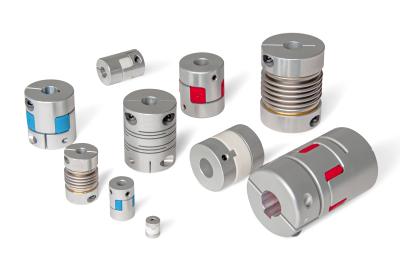
Couplings from JW Winco transmit rotary motions and torques from shaft to shaft. They also even out tolerances and mechanical deflection that would otherwise result in damage to drive or measurement configurations.
Winco’s portfolio includes the perfect coupling solution for practically every situation.
Like all mechanical parts, shafts are subject to manufacturing and assembly tolerances that generally cannot be entirely eliminated even with extensive technical measures. Without compensation of these mechanical deviations, they can cause vibrations, noises, and stiffness, eventually reducing the lifespan of the connected units.
The standard part professionals at Winco tackled precisely these problems. The result is couplings that can be used for torque and power transmission as well as position and motion control. In other words, the right coupling type is available for every application.
Despite the wide variety, finding the right design is easy. A type overview highlights the most important features of every coupling at a glance, while the proven standard sheets document the details of the individual coupling standards. Further technical information on installation and use as well as speeds, temperatures, torsional stiffness, moment of inertia, etc. are summarized in the coupling’s brochure – available as a PDF download on our website.
The recently added couplings of aluminum and stainless steel include designs for positive and non-positive connections. Multiple bore diameters, various, stiffness and hardness levels of the coupling body as well as an optional keyway allow very specific customization to the given use case. In general, all couplings compensate for offsets and misalignments, accommodate runout error and axial motion, and dampen vibrations and impacts to varying degrees.
At the application level, there is a choice between position and motion control or torque and power transmission.
For position and motion control, the rotary motion must be transmitted with very high precision and accuracy. This requires a coupling type that functions with zero backlash in the direction of rotation and has high torsional stiffness. Typical applications include: Servo and stepper motors for linear axes, industrial robots and test benches.
For torque and power transmission, on the other hand, the focus is on pure force transmission. This calls for couplings that can withstand high torques and heavy loads while functioning reliably in harsh conditions. Typical applications include: Conveyor systems, pumps and agitators, packaging machines.
Contact Details
Related Glossary Terms
- backlash
backlash
Reaction in dynamic motion systems where potential energy that was created while the object was in motion is released when the object stops. Release of this potential energy or inertia causes the device to quickly snap backward relative to the last direction of motion. Backlash can cause a system’s final resting position to be different from what was intended and from where the control system intended to stop the device.
- hardness
hardness
Hardness is a measure of the resistance of a material to surface indentation or abrasion. There is no absolute scale for hardness. In order to express hardness quantitatively, each type of test has its own scale, which defines hardness. Indentation hardness obtained through static methods is measured by Brinell, Rockwell, Vickers and Knoop tests. Hardness without indentation is measured by a dynamic method, known as the Scleroscope test.
- stiffness
stiffness
1. Ability of a material or part to resist elastic deflection. 2. The rate of stress with respect to strain; the greater the stress required to produce a given strain, the stiffer the material is said to be. See dynamic stiffness; static stiffness.
